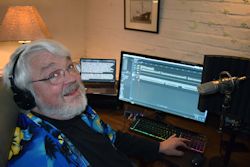SEJournal Online is the digital news magazine of the Society of Environmental Journalists. Learn more about SEJournal Online, including submission, subscription and advertising information.
 |
| Screenshot of an online class on coronaviruses taught by Dave Poulson of Michigan State University, showing environment journalism students taking part by video. Click to enlarge. |
EJ Academy: Pandemic Offers Challenges, Opportunities for Teaching
By Bob Wyss
Some universities that closed their campuses because of the coronavirus pandemic gave their professors two weeks or more to prepare to teach their classes online. Others gave them just two days to make the switch.
The reactions so far from educators have ranged from scared to cautiously optimistic.
“I feel overwhelmed,” said Bill Kovarik, a veteran journalism professor at Radford University and longtime Society of Environmental Journalists member.
Emilia Askari, another longtime SEJ member who co-teaches an environmental and public health course at the University of Michigan, surveyed her students about how the coronavirus and closures were affecting them. Reactions ranged from “eye-opening to heartbreaking,” she reported.
These concerns are all warranted. Setting up an effective online course is not easy. I have taught an online course for several summers and I was fortunate to work for a year with a professional online education consultant to get the content right.
Plus, there are continuing concerns about bandwidths, Internet reliability, software technical glitches and especially equity issues. Education experts are especially worried about what percentage of low-income students have the equipment and the access to take courses online.
Most are confident that they and
their students will overcome the
learning obstacles posed by the crisis.
Still, interviews with several SEJ journalism professors and a review of various professors commenting on online forums indicate that most are confident that they and their students will overcome the learning obstacles posed by the crisis.
Dave Poulson, senior associate director of Michigan State University’s Knight Center for Environmental Journalism and former SEJ academic board member, said in an email that the transition to online has been “fairly seamless.”
He added: “I had to scramble and come up with some different assignments and lessons. But I had no choice and it forced me to try some new things I wouldn’t have otherwise tried.”
It doesn’t hurt that journalism educators are virtually all former reporters, editors and photographers who are used to new challenges in technology. As journalists, we have all had to overcome unusual situations to get a story.
Choosing between teaching live or ‘on tape’
One of the biggest issues many instructors have faced has been whether to teach classes online live or with pre-recorded lectures through PowerPoint or videos.
Virtual reality courses allow for spontaneous discussions, but they can become difficult to control in larger classes. Experts say microphones from multiple computers or cell phones can create a fair amount of unnecessary noise and feedback that can be difficult to control.
Poulson offered another interesting twist. He taught one course using the software conferencing program Zoom because he wanted to continue the face-to-face discussions that have been a vital part of what happens in his classroom.
But a number of students did not want to switch on the video portion of Zoom.
‘Requiring them to show themselves
helped make sure they were paying attention
and encouraged them to respond.’
“I don’t know if they wanted to stay in their pajamas, sleep or were just too shy,” he said. “But requiring them to show themselves helped make sure they were paying attention and encouraged them to respond.”
Using pre-recorded lectures means that in many cases the instructor can rely on material that has already been prepared and already shown to be effective. But transitioning from an existing lecture with PowerPoint slides to an online site, and adding a voice-over narrative, can be challenging.
Kovarik said he was struggling with this and that the university technical staff, probably already overwhelmed, had been of little help.
If faculty do post their lecture material online, Kovarik suggested they should consider copyrighting the work, assuming the school grants such rights to instructors.
Stick with the tried-and-true or tear it up?
The coronavirus crisis has also raised an interesting dilemma for instructors: Does one follow an existing curriculum that is established, tested and in many cases already half completed? Or do you tear it up to take advantage of an important point in history, a public health crisis the world has not seen in a century?
Askari, who teaches with SEJ member Julie Halpert, said they have emphasized to students that while we are undergoing a tragedy it also offers an interesting place in understanding both the environment and public health.
 |
| Bill Kovarik, a veteran journalism professor at Radford University in Virginia, at his online teaching work station. Click to enlarge. |
I would agree. To understand how to cover the environment one has to know how science operates. Environment beat reporters must know how scientists do research, how they assess the accuracy of that research and how they communicate it. In understanding how that research works, we must understand how risks, especially health risks, are interpreted, how regulators use science and how public policy is made from science.
Unfortunately, the crisis we are witnessing is at least partly because of a failure of communication, regulators and public policy. Still, what we are witnessing is a great classroom for our students, one that apparently is going to continue for weeks.
Meanwhile, one of the hallmarks of all good teaching is to connect with students. And that remains important in all online courses.
Askari said that one of the best suggestions she found was to send out an optional survey to students. Some of the questions asked how the national crisis was affecting the student and their family, how students were staying in touch with each other and if they had encountered any complications.
About half of her 22 undergraduates, many of them seniors, responded and it allowed them to express a range of emotions about no longer being on campus. “One of the big challenges in this situation is emotional,” Askari said.
We will all be watching and I hope to report back in the coming weeks, when academic semesters and quarters are ending, regarding what we have all learned about reporting during a pandemic.
In the interim, since many journalism courses rely on students producing news stories, a special challenge when students are no longer on campus, EJ Academy will explore that issue separately in an upcoming issue of SEJournal Online.
Bob Wyss, EJ Academy editor, is a professor of journalism emeritus from the University of Connecticut and the author of three books, including the textbook “Covering the Environment, How Journalists Cover the Green Beat.”
SIDEBAR: Resources for Teaching OnlineWant to improve what you are teaching online while your campus is closed by the coronavirus pandemic? Here are numerous online resources:
|
* From the weekly news magazine SEJournal Online, Vol. 5, No. 12. Content from each new issue of SEJournal Online is available to the public via the SEJournal Online main page. Subscribe to the e-newsletter here. And see past issues of the SEJournal archived here.














 Advertisement
Advertisement 




